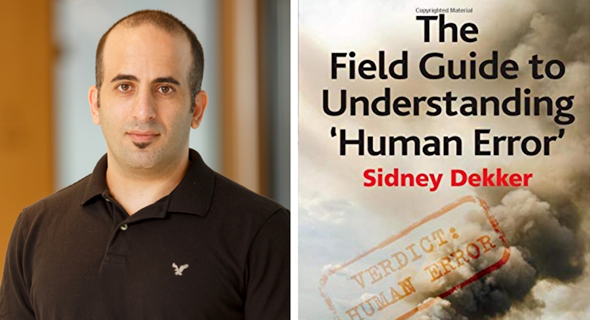BiblioTech
CTech's Book Review: An analysis in human behavior, risk, and systems thinking
Dotan Nahum, CEO at Spectral, shares insights after reading “The Field Guide to Understanding Human Error” by Sidney Dekker
Title: The Field Guide to Understanding Human Error
Author: Sidney Dekker
Format: Book
Where: Home
 Dotan Nahum is the CEO at Spectral. Photo: PR/Amazon
Dotan Nahum is the CEO at Spectral. Photo: PR/Amazon Summary:
Sidney Dekker is a pioneer in analyzing human behavior, risk, and systems thinking. “The Field Guide to Understanding Human Error” is his seminal work about understanding human-systems interactions through day-to-day safety incidents, where "systems" can be products, companies, organizations, or the classical example - airliner incidents.
Usually, when an incident happens, bias and our painfully underdeveloped human nature make us point to a specific person to blame as the root cause to close the deal and move on. Dekker highlights and proves that in actuality, the root cause is the environment that caused an incident and not people. Thinking about errors and mistakes and how to prevent them systematically, teaches us about how to build organizations, because “underneath every simple, obvious story about ‘human error,’ there is a deeper, more complex story about the organization.”
- CTech’s Book Review: Discovering the six principles of persuasion
- CTech's Book Review: Ahoy! What organizations can learn from a ship's captain
- CTech's Book Review: An amazing playbook for designing a category and taking it to market
Important Themes:
Human bias is something we all have. To get a clear view of reality, and to really make progress, we must be aware of it and systematically correct it. Bias in human nature makes us identify a "person to blame" and work backward from that to explain the incident, which is very wrong. This is called the "Bad Apple Theory" - quickly finding a person to blame is cheap and easy, and it saves face.
In the real world, every critical incident involves multiple parameters at once. The key is to create a process, get the chain of events right of how we reacted to failure, and identify the root cause in the system and environment and not in people which operate in it. Dekker provides a real-world system that's being used in flight incident investigation for this.
Management should take responsibility for the environment in which people are operating, and learn from errors by improving and modifying that environment. Remember: “People were doing their best given the complexities, dilemmas, trade-offs, and uncertainty that surrounded them.”
What I’ve Learned:
Understand that what you know now is different than what "they" knew then. Where "they" is the people that were involved and operated within the incident.
Creating a learning organization and learning from mistakes must be a very systematic, orderly process, to avoid human biases "slipping in the cracks."
The true challenge of improving organizations is the ability for leaders to "see" just the environment and system surrounding the people in it, understand what's wrong with the environment and system, and how it contributes to humans failing in it.
In this perspective that Dekker brings, human error is fascinating surprisingly because we learn not about the human, but about how to properly build products and organizations.
And lastly a mantra for life, from the book: "The reconstruction of the mindset begins not with the mind, it begins with the circumstances in which the mind found itself."
Who Should Read This Book:
Any leader of any team, CEOs, or team leaders who want to build an extremely effective organization where people in it are happy and productive.



